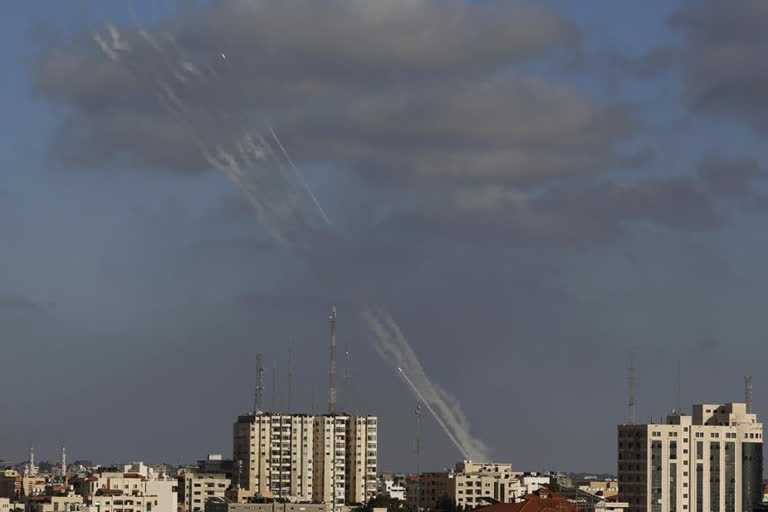Jerusalem: More than a week into their fourth war, Israel and the Hamas militant group already facing allegations of possible war crimes in Gaza. Israel says Hamas is using Palestinian civilians as human shields, while critics say Israel is using disproportionate force.
Who’s right? It’s hard to say, especially in the fog of battle.
The firing of hundreds of imprecise rockets into Israel by Hamas and other Palestinian groups is fairly clear-cut. International law prohibits targeting civilians or using indiscriminate force in civilian areas. Rockets slamming into Tel Aviv apartment blocks is a clear violation.
But in Gaza, where 2 million people are packed into a narrow coastal strip, the situation is far murkier. Both sides operate in dense, urban terrain because that’s pretty much all there is. Because of the tight space and intense bombardments, there are few safe places for Gazans to go. A blockade imposed by Israel and Egypt after Hamas seized power in 2007 makes it virtually impossible to leave.
Read:| Six-month-old baby survives deadly Israeli airstrike
As a grassroots movement, Hamas is deeply embedded in Palestinian society, with a political operation and charities separate from its secretive armed wing. While Israel and Western countries view Hamas as a terrorist organization, it is also Gaza’s de facto government, employing tens of thousands of people as civil servants and police. So just being connected to Hamas doesn’t mean someone is a combatant, and many in Gaza oppose the group — and all are equally exposed with nowhere to run.
Here’s a look at potential violations of international law:
URBAN COMBAT
Palestinian fighters are operating in built-up residential areas and have positioned tunnels, rocket launchers and command and control infrastructure near schools, mosques and homes.
A prosecutor would have to prove that the combatants deliberately placed military assets near civilians to benefit from protections afforded to non-combatants during the war.
“If France invades Switzerland, the Swiss are not prohibited from defending Geneva, including by putting Swiss soldiers, Swiss artillery positions and so on inside Geneva,” said Marco Sassoli, professor at the Geneva Academy of International Humanitarian Law and Human Rights.
Because international humanitarian law applies to all sides in any conflict, the French could fight in Geneva as well. But here the issue of proportionality applies on the big picture level: To continue the analogy, was the French assault on Geneva proportional to the provocation?
PROPORTIONALITY
Israel’s critics often accuse it of the disproportionate use of force. They note that the undeclared nuclear power, with the region’s most powerful military, is waging war on a militant group armed with little beyond long-range rockets, the majority of which are intercepted by Israel’s anti-missile defences. As in the past, the toll in the current conflict is dramatically lopsided, with at least 200 killed in Gaza, nearly half of them women and children, and 10 in Israel, all but one of them civilians.
Israel argues it has the right to eliminate the threat from rockets, including command infrastructure connected to it. It says it makes every effort to avoid harming civilians, including by warning them ahead of some strikes. But Sassoli said that in past conflicts, Israel had a “quite large concept of what is a legitimate military objective.”
Proportionality in international law also applies to individual attacks, but experts say proving a specific attack is disproportionate is extremely difficult. One would need to know what was targeted, what military advantage was gained, and whether it exceeded the harm inflicted on civilians and civilian property. That means that in practice, only the most extreme cases are likely to be prosecuted.
On Saturday, Israel bombed a 12-story building housing the Gaza offices of The Associated Press and the Al-Jazeera news network, as well as dozens of private apartments and small businesses, including a law firm, a lab for blood testing and a TV production company.
Read:| Over 200 dead in Gaza fighting, says UN
The Israeli military warned residents to evacuate the building, and no one was hurt.
The military says there was a considerable Hamas presence in the building, including a command and control centre, an intelligence unit and other infrastructure used to coordinate combat operations. But it has provided no evidence.
AP President and CEO Gary Pruitt has said he was “shocked and horrified” by the attack, and AP has called for an independent investigation. “We do not indicate a Hamas presence in the building, nor were we warned of any such possible presence before the airstrike. This is something we check as best we can,” Pruitt said Monday.
Sassoli said it would be “completely unlawful” to attack a media centre, but it’s impossible to know whether the bombing was justified without knowing what the military was targeting.
Strikes causing civilian casualties raise strong proportionality questions.
On Sunday, Israel launched heavy airstrikes along the main thoroughfare in Gaza City, saying it was targeting Hamas’ “underground military infrastructure.” The bombardment toppled three buildings and killed at least 42 people, including 16 women and 10 children. A day earlier, a strike in a crowded refugee camp killed 10 women and children. Israeli media said the military was aiming for senior Hamas officials meeting in the building.
UNDERGROUND ARMY
Members of Hamas’ armed wing rarely if ever wear uniforms or identify themselves in public, and they go underground as soon as hostilities begin, along with the political leadership.
The vast majority of Hamas supporters are not involved in fighting, which means they aren’t supposed to be targeted. The International Committee of the Red Cross defines a combatant as someone with a “continuous combat function” or those engaged in combat at the time they are targeted, a widely adopted definition.
So even if a building were filled with die-hard Hamas supporters, experts say it wouldn’t be considered a legitimate target unless they were actively involved in combat operations.
AP



